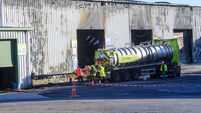People who work nights and shifts at higher risk of workplace injury

Night workers, shift workers and new recruits are at a higher risk of workplace injury, compared to staff not working these hours.
That is according to new ESRI and Health and Safety Authority (HSA) research out today, which tracked experiences from 2001 to 2014.
It has also found the health sector has the most days lost per worker to due to work-related illness.
In this sector, 524 days were lost per 1,000 workers. This was followed by transport (507), agriculture, forestry and fishing (358), industry (351) and was lowest in construction (313).
The health sector had the highest number of days lost per worker due to work-related illness according to a new study by the ESRI and @TheHSA #ESRIpublications https://t.co/9ZhMD2RjpB pic.twitter.com/jQ9loJYyXV
— Economic and Social Research Institute (ESRI) (@ESRIDublin) April 19, 2018
Longer working weeks are associated with injury. Construction sector workers working between 40 and 49 hours a week faced a greater likelihood of injury per hour worked, after adjusting for worker and job characteristics.
"The research published today will greatly assist in identifying employees across a range of sectors who might be at risk of workplace related injury or illness," said Pat Breen, TD, Minister of State with special responsibility for Trade, Employment, Business, EU Digital Single Market and Data Protection.
"This will enable businesses to improve health and safety standards in the workplace and to reduce staff absences which also ultimately affect the productivity and growth of a business."
The rate of fatalities is highest in the agriculture, forestry and fishing sector.
The agriculture, forestry and fishing sector has the highest fatality rate, according to a new study by the ESRI and @TheHSA. It was the only sector to see an increase in fatalities in the 2001 to 2014 period. #ESRIpublications https://t.co/9ZhMD2RjpB pic.twitter.com/6RFMU2ywvk
— Economic and Social Research Institute (ESRI) (@ESRIDublin) April 19, 2018
The number of fatalities increased from 129 in the 2001-2007 period to 151 in the 2008-2014 period.
The combined fatalities in industry, construction, transport, and agriculture, forestry and fishing accounted for 85% of all worker fatalities in Ireland in 2014.
"Our research shows that new recruits in construction, health, agriculture and transport have a significantly higher risk of occupational injury," said Helen Russell, Research Professor at the ESRI.
"Hence, there is need for supervision, training, and support to prevent rising injury and illness rates."












